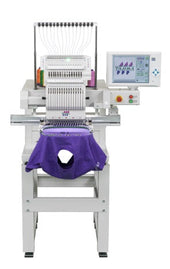
What to Consider Before Adding a New Industrial Sewing Machine to Your Production Floor
Adding a new industrial sewing machine might sound like a simple equipment purchase, but for many New Zealand businesses, it means adjusting systems that impact daily operations. Whether you’re scaling output or replacing ageing machinery, each new addition affects floor space, power consumption, operator performance, and production timelines.
If the process isn’t planned correctly, it can create bottlenecks, inefficiencies, or worse—safety risks.
For operations managers, business owners, and procurement teams in the garment and upholstery sectors, this guide lays out what to consider before adding equipment to a live production environment.
From space allocation to staff training, we’ll walk through essential steps to avoid disruption and maximise returns.
Planning Your Factory Layout for Industrial Sewing Machines

Before a machine arrives, the first step is assessing your layout. The way you position workstations, walkways, storage, and raw material zones determines how smoothly your process runs. Even one poorly placed machine can slow down production.
Understanding Flow and Spacing
Plan your layout to support a linear flow of materials. Fabric should move efficiently from cutting to sewing to finishing, without backtracking. This reduces the time lost to moving materials and lowers the chance of errors.
How Much Space Should Be Left Around an Industrial Sewing Machine?
Important: Allow at least 1.2 to 1.5 metres of clear space around the machine. Operators need room to load materials, make adjustments, and exit quickly in case of emergencies. This also allows safe movement and avoids disrupting workflow.
How Does Machine Placement Affect Production Efficiency?
Poor placement can lead to material handling delays, longer production times, and more operator fatigue.
Lighting and Ventilation
Machines generate heat. Add bright but non-glare lighting, and make sure air can flow freely. Heat build-up affects both equipment longevity and operator comfort.
This kind of attention to layout supports better production layout efficiency and avoids unexpected slowdowns during shifts.
What Should I Do Before Expanding My Production Facility?
Audit current workflow, check spatial limitations, and confirm electrical availability before introducing new machines.
Electrical Load: Are You Ready?
Electrical Infrastructure for New Equipment
Not all industrial sewing machines draw the same power. Some newer models run on standard 230V single-phase power, while others require 400V three-phase. Installing a machine without checking circuit compatibility can trip breakers or damage wiring.
This is where understanding the electrical load for commercial machines is critical. It’s not just about wattage—it’s about surge capacity, circuit load balancing, and grounding.
Working with Professionals
Always consult a certified electrician before installation. They can assess whether your switchboard, breakers, and circuits can safely support additional machinery. If not, upgrades might be required.
What Should I Do Before Expanding My Production Facility?
Some machines allow this, but others require higher voltage or dedicated circuits. Check the spec sheet before installation.
What Power Supply Is Needed for Industrial Sewing Machines in NZ?
Most machines require 230V, but commercial models may use 400V three-phase. Your electrician can confirm compatibility.
This step protects not only your new machine but also every other piece of equipment on the same line.
Preparing Operators for the New Equipment

Why Operator Training Shouldn’t Be Overlooked
Staff familiarity with older machines doesn’t guarantee success with new models. Modern industrial sewing machines often come with automation features, computerised settings, and high-speed functions that operators may not be used to. Some upgrades introduce digital control panels, automatic tension systems, laser guides, or programmable patterns.
Even experienced teams need time to adjust to unfamiliar controls and responsiveness. Training isn’t just a safety formality—it determines how quickly a machine reaches optimal performance.
Untrained operators are more likely to make errors, damage materials, or cause downtime by mishandling machine functions. Moreover, poor handling early on can lead to long-term wear and tear.
A strong focus on operator training for sewing equipment also shows your staff that you’re investing in their skills. It improves morale and reduces pushback during transition periods.
In-House or Supplier-Led Training?
Suppliers like Sewingtime NZ often provide free or discounted training when you purchase from them. This training usually covers basic machine setup, threading, software navigation (if applicable), maintenance routines, and troubleshooting.
If supplier-led sessions aren’t available, consider in-house walkthroughs using training materials or online modules. Assign a senior staff member to act as the initial point of contact for questions.
Hands-on time is essential. It’s not enough to read a manual—operators should practise under supervision until they can operate the machine confidently.
Do Operators Need Certification To Use New Industrial Machines?
Not usually, but documented training improves safety and reduces downtime.
How Long Does It Take To Train Staff on New Machinery?
Depending on complexity, allow at least 2–5 days of hands-on time before running full shifts.
Maintenance Starts Before the Machine Arrives

Build a Preventive Maintenance Schedule
A new machine is only as reliable as your plan to keep it that way. Establishing a maintenance schedule before the first run helps avoid bad habits from forming.
Each model will have different requirements, but a general guideline includes:
-
Daily tasks: Clean lint buildup, check thread path, inspect for loose screws
-
Weekly tasks: Oil moving parts, check bobbin case and hook assemblies
-
Monthly tasks: Test motor responsiveness, inspect belts and timing
Having a clear plan aligns with standard equipment maintenance in manufacturing and helps operators understand their responsibilities. You can attach maintenance tags directly to machines or use digital logs if your team already uses work management software.
Consistency in routine maintenance prevents unexpected downtime, extends the machine’s lifespan, and protects your investment.
What Is a Good Maintenance Schedule for Industrial Sewing Machines?
Clean daily, oil weekly, and inspect belts monthly. Adjust based on usage and manufacturer advice.
Keep Spare Parts on Hand
Delays caused by missing parts are avoidable. Stock up on essential components prone to wear and tear. These often include:
-
Needles
-
Bobbin cases
-
Tension springs
-
Loopers
-
Belts
-
Oil
Sourcing these in bulk when ordering from a supplier like Sewingtime NZ saves time and ensures continuity.
What Parts Should I Keep in Stock for Sewing Machine Maintenance?
Keep extra needles, bobbin cases, tension springs, and oil. These wear out fastest under heavy use.
Common Pitfalls When Adding Equipment
Mistakes That Disrupt Workflow
Adding equipment without proper planning can introduce more problems than solutions. These mistakes are more common than most managers expect:
-
Failing to check circuit compatibility: This can cause blown fuses or long-term electrical damage.
-
Ignoring airflow or lighting needs: Machines placed in dim, cramped areas cause eye strain and discomfort.
-
Rushing operator training: This leads to lower output, increased mistakes, and machine misuse.
-
Skipping floor plan adjustments: New machines may interfere with walkways, storage access, or emergency exits.
What Are Common Mistakes When Setting Up New Production Equipment?
Poor power planning, limited space, and untrained staff are the most frequent issues.
Should I Lease or Buy New Industrial Sewing Machines?
Leasing offers flexibility and lower upfront costs, but buying may save more long term if usage is consistent.
One overlooked but growing issue is mismatched machine capacity. Adding a machine with features your workflow doesn’t need—or worse, one that doesn’t integrate with existing systems—can cause more hassle than help. A good machine integration strategy aligns equipment capability with production needs.
Final Checklist Before Going Live
Before you turn on the power and load the fabric, confirm the following:
-
Machine is positioned safely and clearly accessible
-
Power requirements are matched and tested
-
The operator has completed the walk-through and test runs
-
A maintenance plan is recorded and understood
If even one box isn’t ticked, postpone the rollout. Fixing issues after startup is harder and costlier.
How Do I Know if My Production Floor Is Ready for Expansion?
Review your layout, equipment spacing, power supply, and staff capacity before moving ahead.
Encouraging a Culture of Preparedness
Machine installation shouldn’t be treated as a one-time event. Documenting layouts, tracking issues, and maintaining operator feedback all contribute to smoother upgrades in the future.
Internal standard operating procedures (SOPs) help build consistency as teams grow. A good habit is to perform quarterly reviews: check if machines are underperforming or if workflow bottlenecks are creeping in.
This ties into long-term planning and the reality of adding equipment to textile operations. Every machine should help, not hinder, your production goals.
Ready To Expand?
Adding industrial sewing machines to a production floor requires more than finding space. It demands a full review of workflow, electrical capacity, operator readiness, and long-term maintenance. If done right, it’s a low-risk way to increase capacity and output.
NZ-based garment and upholstery businesses that plan carefully tend to experience fewer breakdowns, faster rollouts, and safer workspaces. From layout design to team training, the work you put in before installation directly affects your returns.
Invest the time upfront, and your new machine will pay off for years to come. If you’re still unsure about the preparations you need to do before buying more machines for your business, you can always contact our team at Sewingtime Ltd, and we’ll get you sorted!



